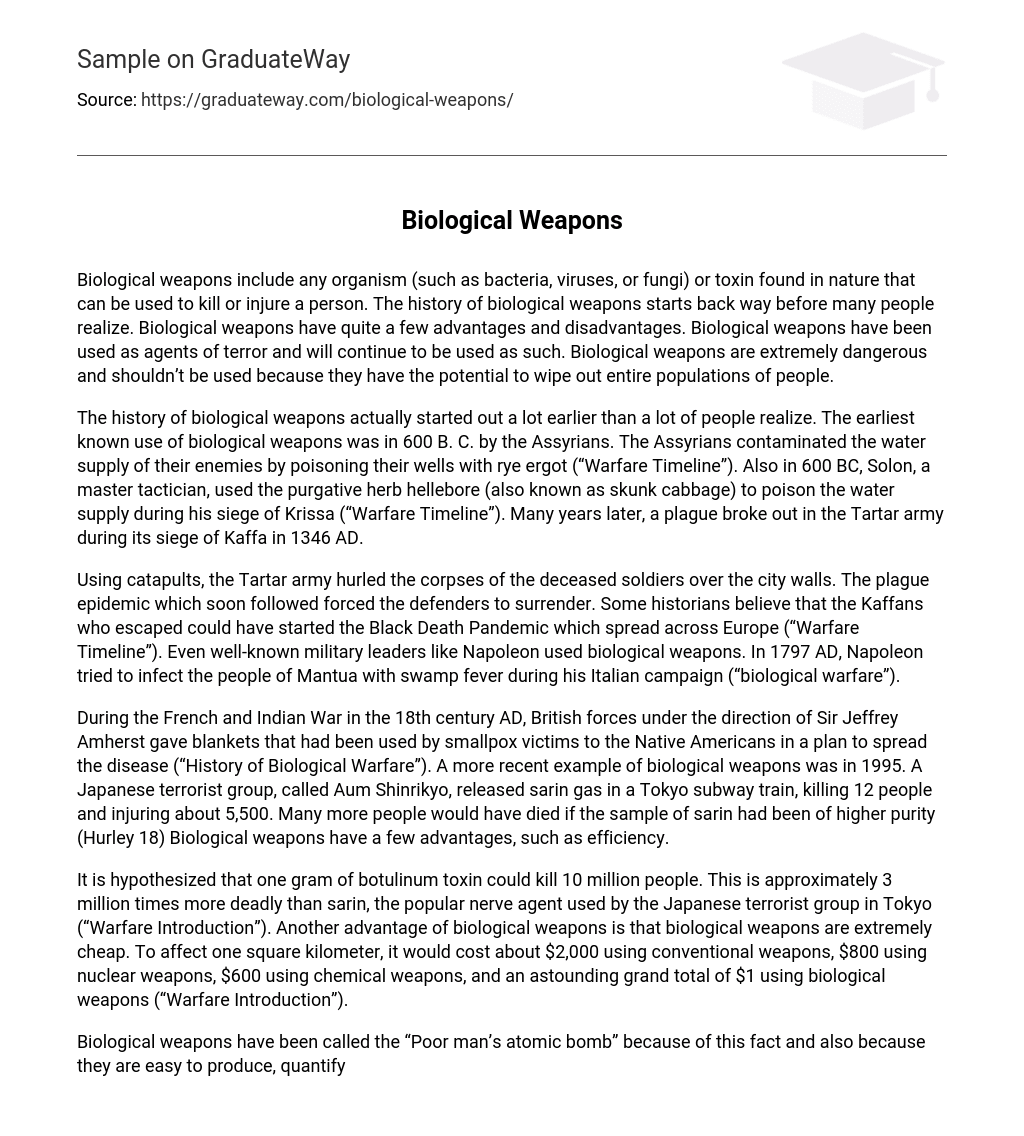Biological weapons, which encompass organisms like bacteria, viruses, and fungi as well as toxins occurring naturally, have the capacity to cause harm or death. The origins of biological weapons date back further than commonly acknowledged. Such weapons possess both advantages and disadvantages. Often employed as tools of terror, their utilization is expected to persist. However, due to their immense peril and ability to decimate entire populations, the use of biological weapons should be strictly prohibited.
The history of biological weapons started earlier than commonly believed. The Assyrians first used biological weapons around 600 B.C by poisoning their enemies’ water supply with rye ergot (“Warfare Timeline”). In the same period, Solon, a skilled tactician, utilized the purgative herb hellebore, also known as skunk cabbage, to contaminate the water supply during his siege of Krissa (“Warfare Timeline”). In 1346 A.D, a plague erupted within the Tartar army while besieging Kaffa.
Using catapults, the Tartar army launched the bodies of dead soldiers over the city walls, leading to a subsequent plague epidemic that compelled the defenders to surrender. Some historians speculate that those who managed to escape from Kaffa could have instigated the spread of the Black Death Pandemic throughout Europe (“Warfare Timeline”). Even renowned military figures like Napoleon resorted to employing biological weapons, as evidenced by his attempt in 1797 AD to infect the population of Mantua with swamp fever during his Italian campaign (“biological warfare”).
During the 18th century AD, British forces deliberately exposed Native Americans to smallpox by giving them blankets that had been used by smallpox victims. This was part of their strategy to spread the disease (“History of Biological Warfare”). In a more recent event in 1995, the Japanese terrorist group Aum Shinrikyo released sarin gas inside a Tokyo subway train. The attack caused 12 deaths and around 5,500 injuries. If the purity of the sarin gas sample had been higher, there would have been even more casualties (Hurley 18). Biological weapons offer advantages due to their efficiency.
It is believed that a gram of botulinum toxin has the potential to cause the death of 10 million individuals, making it about 3 million times more lethal than sarin, the nerve agent utilized by the Japanese terrorist organization in Tokyo (“Warfare Introduction”). Additionally, biological weapons offer the advantage of being incredibly inexpensive. The cost to impact an area of one square kilometer is roughly $2,000 with conventional weapons, $800 with nuclear weapons, $600 with chemical weapons, and an astonishingly low total of $1 with biological weapons (“Warfare Introduction”).
Biological weapons are often referred to as the “Poor man’s atomic bomb” because they can be easily produced, measured, and weaponized. Additionally, their concealment is made simple because the equipment required for production has multiple lawful purposes, such as centrifuges, culture flasks, and petri dishes. These weapons possess a particularly perilous attribute – their “live” nature, unlike conventional weapons which detonate once.
Biological weapons have the ability to cause massive casualties and spread easily among individuals. By infecting a few carriers, thousands of others can become infected, leading to an epidemic. However, their unpredictability poses as a major disadvantage as accidental infections can occur among one’s own troops or innocent people. Moreover, biological agents have a long lifespan.
“Warfare Introduction” states that Anthrax can survive in soil for 50 years, making it impossible to send troops to occupy contaminated areas. Various terrorist groups, including the aforementioned Japanese organization, have used biological weapons throughout history. The public’s fear of a potential smallpox terrorist attack is widespread due to its invisible and odorless nature, causing apprehension among people.
Smallpox has a lower chance of being detected and eliminated due to its characteristics (“Terrorism Smallpox”). The cessation of global smallpox vaccinations over 20 years ago has made almost everyone vulnerable to the disease. If a terrorist group were to acquire the virus, the consequences would be extremely dangerous considering the limited availability of smallpox vaccines. Even if smallpox were used as a weapon, it is unlikely that the disease would be quickly identified, making vaccination programs ineffective.
If terrorists strategically employed smallpox, they could decimate entire populations (“Terrorism Smallpox”). Biological weapons have a lengthy and tumultuous history and are expected to persist. Despite some advantages over other arms, they possess more drawbacks. Due to their capacity to annihilate entire populations, biological weapons are exceedingly perilous and should not be utilized. Implementing a ban on biological weapon programs is imperative to avert the numerous adverse consequences associated with them.





